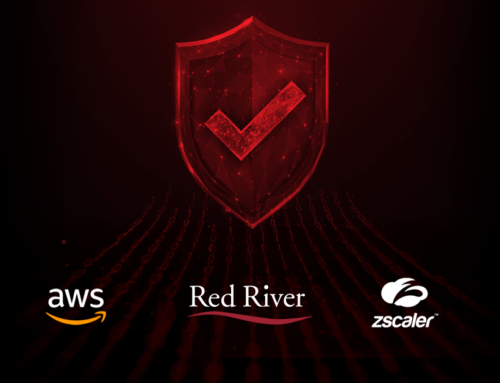
SOCaaS: Why an Outsourced SOC Might Be Your Best Next Move
In a perfect business world, money and talent would be abundant and cybercriminals would not exist. We don’t live or work in such an environment. Instead, company leaders are tasked with maximizing their cybersecurity investment because hackers orchestrate more than 2,220 cyberattacks every day. If you want the sense of security that comes with having talented people and advanced technologies protecting your digital assets, an outsourced Security Operations Center (SOC) may be the solution.
What Is SOCaas?
A SOC enhances a company’s ability to detect imminent threats, deter bad actors from penetrating a network and expel burglars on the cusp of a successful breach. These tasks are accomplished by pulling together wide-reaching cybersecurity technologies and operational capabilities.
Typically pronounced as a “Sock,” the informational protection center can be set up in-house or outsourced to a managed IT firm specializing in SOC cybersecurity. When outsourced, industry insiders generally tack on the letters “aaS” that refer to “as a Service.” Regardless of whether an organization chooses to run its own internal SOC or broker a deal to outsource the SOCaaS, the defensive functions usually run 24 hours a day, 7 days a week.
That’s largely because hackers in other countries take advantage of downtime. When no one is watching the proverbial store, cybercriminals can strike with impunity, locking down entire networks or stealing valuable and sensitive digital assets. The latter often results in bank accounts, credit cards, Social Security numbers, trade secrets and other information being sold on the Dark Web.
Industry leaders generally prefer the proactive nature of a SOC or SOCaaS because it provides real-time defenses against threat actors. When properly defined and incorporated into an enterprise’s overall digital architecture, cybersecurity professionals can respond faster and with greater determination. Falling just minutes behind a sophisticated hacker can leave legitimate users locked out of their own network. And the ransom demands that follow can be staggering.
Could a SOC Have Prevented These Data Breaches?
First American Financial Corp suffered a massive data leak in 2019 that compromised upwards of 885 million files. According to reports, the records at its First American Title Insurance unit included bank account numbers, mortgage information, driver’s licenses and wire transfers, among others. Technically, the incident was a leak, not a brute force breach, because its origin was traced to a web design flaw. Not only did the institution suffer a black eye to its reputation, but it was also hit with legal action and ordered to pay a $1 million fine.
The Real Estate Wealth Network suffered a data breach in 2023 that saw 1.5 billion records exposed. The identities of property owners, investors, tax information, loan amounts and sellers were reportedly pilfered off. Among them were celebrities and other high-profile people, such as Britney Spears, Mark Wahlberg and Nancy Pelosi. The company could not easily determine how long hackers had been inside their database or a complete inventory of stolen information.
A well-run security operations center would likely have identified the First American Financial Corp website vulnerabilities. The idea of hackers running roughshod over the Real Estate Wealth Network for months would have been significantly less likely – even virtually impossible – if an experienced SOCaaS provider was involved.
How Cybersecurity Experts Establish a SOCaaS
Much of the heavy lifting comes in the early stages of setting up a SOC or SOCaaS. Completing a comprehensive physical or virtual security operation requires diligent preparation and planning. These are fundamental procedures that must be conducted by an experienced cybersecurity expert to establish the defense.
- Inventory Compilation: An exhaustive database must be compiled that accounts for every shred of information that requires protection. These digital assets are not restricted to information housed on office hard drives or Cloud-based storage. Every endpoint device must be assessed to determine the data it maintains and may transmit going forward. Third-party experts can employ specialized data discovery technologies to fast-track the process.
- Maintenance Preparation: Automation is one of the key factors used to heighten effectiveness and minimize costs. The cybersecurity experts who create the SOC infrastructure can integrate technologies that provide preventative solutions. For example, setting up the system to perform software patches and upgrades helps prevent zero-day attacks.
- Automatic Backups: It’s important to keep in mind that sly hackers never stop trying to find a workaround to the best cybersecurity defenses. Last year, MGM Resorts International was brought to its knees by a group of young hackers. The miscreants cost MGM upwards of $100 million and devastating reputational losses. They came up with an elaborate scheme to circumvent seeming impenetrable defenses. That’s why daily backups are mission critical. A SOC or SOCaaS can be designed to back up your system to offset the setbacks of a ransomware attack.
- Proactive Incident Response: A well-orchestrated security posture goes far beyond sending alerts and notifications. It uses AI and machine learning to filter out routine false positives and advances credible threats. Experts who create SOCs typically have the knowledge and skills to refine systems. When companies outsource their SOC needs, third-party consultants can also initiate a strategy known as “threat hunting.” Rather than passively wait for something to go sideways, cybersecurity professionals go looking for vulnerability and telltale signs a bad actor has targeted a business network.
Along with these foundational steps, cybersecurity professionals can leverage the operation’s assets to conduct regular testing. Penetration testing, for example, mimics strategies sophisticated hackers use to breach a company’s network.
Telltale Signs You Need a Security Operations Center
The obvious reason industry leaders see a need to invest in a SOC stems from an uneasiness that your company is vulnerable to attack. If you spend even one restless night worrying that a hacker sitting halfway around the world could be stealing valuable and sensitive information, that is one too many. You know something needs to be done to harden your cybersecurity posture. Adding a SOC would be a definitive solution that allows you to sleep soundly. These are two telltale signs your best option may be to reach out to an expert and integrate a SOC solution.
Differing Concerns
When department heads and other key stakeholders present different cybersecurity concerns, that’s a sign an overarching approach is needed. Putting a series of bandages on departmental weaknesses results in patchwork security prone to inherent gaps. A SOC brings everything together under one umbrella, ensuring comprehensive data security.
Cybersecurity Workforce Shortages
There are multiple reasons why companies struggle to create a robust cybersecurity posture. The primary issue tends to involve a lack of cybersecurity expertise. Forbes Magazine published a piece that indicates the need for skilled cybersecurity professionals grew by 26 percent in 2022. To put that in context, there was a cybersecurity workforce shortage at the beginning of that year. As companies struggle to onboard enough skilled staff members to fill these roles, trainees are often tossed into the fray. By 2025, more than 50 percent of severe cyberattacks are expected to be attributed to a lack of workforce talent.
Benefits of Outsourcing Cybersecurity

To say the benefits of utilizing a SOC or SOCaaS outweigh the collaged approach many organizations deploy would be something of an understatement. This definitive cybersecurity strategy builds defensive architecture and takes a proactive approach to deterring, detecting and eradicating threat actors before they can damage your reputation by stealing critical data. Consider this list of benefits you would enjoy by investing in a comprehensive cybersecurity operation.
- Ongoing Monitoring: Thanks to AI, machine learning and a team of cybersecurity experts, business networks enjoy 24/7 cybersecurity monitoring. Hackers from hostile nations like Iran or Russia are in for a rude awakening when they attempt to breach an American system in the dead of night.
- User Management: The advanced technologies track the subtle ways legitimate users conduct themselves. For example, a particular staff member routinely accesses the files needed to complete their tasks. A hacker has designs on information that can be sold on the Dark Web. When a network profile navigates the system differently, those anomalies trigger alerts.
- Incident Response: Regardless of the skills or dedication an in-house managed IT team provides, they simply cannot be on duty around the clock. When a hacker attempts a breach at 3 a.m., alerts reach people who are asleep. By contrast, a fully staffed SOC has someone on standby 24 hours a day, 7 days a week. When cybersecurity professionals stand ready, threats are dealt with in real time.
- Disaster Recovery: An advanced persistent threat can penetrate the most secure systems in the world, if the hacker decides to invest enough time and energy. The U.S. federal government has repeatedly been hacked despite its endless resources. The point is that stopping 99 percent of cyberattacks still leaves that 1 percent. If a high-level hacking gang decides to target your enterprise or a natural disaster occurs, the regular backups ensure you have safely stored assets to fall back on.
A thriving SOC or SOCaaS offers effective regulatory compliance and business continuity. Along with essential asset protection, it also saves companies money and reputational damages that often result in bankruptcy. The question decision-makers need to consider is whether to staff a full-time SOC or work with a third-party firm to establish a SOCaaS relationship.
In-House SOC vs. SOCaaS
It wouldn’t necessarily be fair to imply that one of the two approaches is inherently better than the other. Both the SOC and SOCaaS systems provide significant benefits. Each has certain drawbacks that may prove prohibitive to organizations. If you are considering hardening your attack surface, closing vulnerabilities and protecting your livelihood from online thieves, these are pros and cons associated with a SOC and SOCaaS.
SOC Pros
- Control: Having an in-house staff gives companies immediate control over their cybersecurity employees.
- Flexibility: A SOC can be made operational on an as-needed basis. It can also function only during working hours if that makes sense for a business.
SOC Cons
- Cost: Hiring cybersecurity experts to handle the SOC can be very expensive. Companies will also need to onboard enough people to manage the SOC while employees take vacation, call out sick, or are away for conferences and training.
- Expertise: An in-house team can bring high-level skills to the table. But they cannot know what they do not know.
SOCaaS Pros
- Scalability: Working with a third-party firm allows companies to fit the cost of a SOCaaS into their budget. The pass-through expense can increase with business growth and profitability.
- Expertise: Outsourcing provides a rare opportunity to utilize a complete cybersecurity team with vast knowledge. These experts undergo ongoing training at no expense to the company that uses the SOCaaS.
SOCaaS Cons
- Privacy: It’s essential to work with a reputable cybersecurity provider. The third-party firm will have access to your sensitive data.
- Communication: Less-than-professional outfits sometimes fail to communicate effectively. This issue can result in security gaps and frustration.
When all things are relatively equal, the critical difference between a SOC and SOCaaS typically comes down to cost. The scalability third-party experts offer for continuous monitoring and threat prevention usually outweighs SOC pros such as staffing control.
How to Choose a SOCaaS Provider?
Working with a managed IT firm with SOCaaS expertise requires high-level trust and comfort. Those are reasons why company leaders would be well-served to vet SOCaaS providers. It’s also prudent to hold a get-to-know-you event to make sure you communicate well and feel comfortable moving forward. While deciding on the right firm for your needs, consider asking the following questions.
- How many cybersecurity professionals will be assigned to SOCaaS responsibilities?
- Does your firm have enough staff for 24/7 cybersecurity monitoring and threat detection?
- What certifications do your cybersecurity professionals hold?
- What technologies do you use to ensure real-time threat detection and response?
- What SOCaaS packages do you offer and do they include flexibility?
The answers to these questions will help you make an informed decision when choosing a SOCaaS provider. That relationship could very well determine whether hackers view your operation as easy pickings or choose to spend their time and energy elsewhere.
Red River Provides Determined & Scalable SOCaaS Solutions
If your organization would benefit from an affordable SOCaaS strategy, Red River has the expertise and skilled staff to protect your digital assets. Contact us today by calling or filling out our online form. Let’s get the process started!

written by
Corrin Jones
Corrin Jones is the Director of Digital Demand Generation. With over ten years of experience, she specializes in creating content and executing campaigns to drive growth and revenue. Connect with Corrin on LinkedIn.




